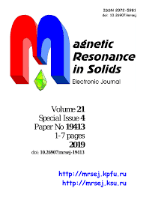
Magnetic Resonance in Solids
Scope & Guideline
Pioneering Discoveries in Electronic and Optical Materials
Introduction
Aims and Scopes
- Magnetic Resonance Techniques:
The journal emphasizes the development and application of various magnetic resonance techniques, including Electron Paramagnetic Resonance (EPR), Nuclear Magnetic Resonance (NMR), and others, to study the magnetic properties of materials. - Solid-State Physics:
A core area of focus is the exploration of solid-state phenomena, particularly in materials that exhibit unique magnetic properties such as superconductors, ferromagnets, and antiferromagnets. - Material Characterization:
Research related to the characterization of materials using magnetic resonance methods is a significant aspect, including studies on the electronic and optical properties of novel materials and heterostructures. - Quantum and Spin Dynamics:
Investigations into quantum states, spin dynamics, and coherence phenomena in various systems are prevalent, reflecting the journal's commitment to exploring fundamental aspects of magnetism and quantum mechanics. - Interdisciplinary Research:
The journal promotes interdisciplinary research that combines physics with chemistry and materials science, particularly in studies involving doped materials and nanostructures.
Trending and Emerging
- Magnetoelectric Coupling:
Emerging research on magnetoelectric materials and their interfaces, as seen in studies involving LaMnO3 and XTiO3 heterostructures, highlights the growing interest in materials that exhibit coupled magnetic and electric properties. - Superconductivity and Magnetism:
There is an increasing focus on the relationship between superconductivity and magnetism, as evidenced by the exploration of phase transitions and interactions in superconducting systems, indicating a rich avenue for future research. - Advanced Material Synthesis:
The trend towards investigating synthesized materials, such as cerium-doped hydroxyapatite and other complex oxides, reflects a broader interest in developing novel materials with tailored properties for specific applications. - Quantum Computing and Spintronics:
Research related to quantum states and spintronics is on the rise, suggesting a growing interest in the application of magnetic resonance techniques to quantum computing and the manipulation of spin states. - Interfacial Phenomena:
The study of interfacial phenomena in heterostructures is gaining prominence, as researchers seek to understand the implications of material interfaces on magnetic and electronic properties.
Declining or Waning
- Basic Theoretical Studies:
There has been a noticeable reduction in purely theoretical papers without experimental validation, as the journal increasingly favors studies that combine theory with practical magnetic resonance applications. - Classical Magnetic Materials:
Research focused on classical magnetic materials, such as conventional ferromagnets, has decreased, possibly due to a growing interest in more complex or novel materials that exhibit advanced magnetic properties. - Low-Dimensional Systems:
While previously a strong focus, studies specifically targeting low-dimensional magnetic systems have waned, suggesting a shift towards more complex multi-dimensional systems and heterostructures.
Similar Journals

MAGNETIC RESONANCE MATERIALS IN PHYSICS BIOLOGY AND MEDICINE
Connecting Science and Medicine Through Magnetic ResonanceMAGNETIC RESONANCE MATERIALS IN PHYSICS BIOLOGY AND MEDICINE, published by SPRINGER, is a premier academic journal dedicated to advancing the fields of biophysics, radiology, and medical imaging. With a strong presence in Germany and an international readership, this journal has established itself as a vital resource for researchers and professionals engaged in the interdisciplinary study of magnetic resonance applications. Featuring a commendable 2023 impact factor and categorized in Q2 quartiles across several domains—including Biophysics and Radiological Technologies—this journal provides a platform for innovative research and practical implementations in the field. Although it does not follow an Open Access model, it offers extensive archives dating back to 1984, affirming its long-standing commitment to scholarly excellence. The journal not only ranks impressively within Scopus metrics, but it also promotes ongoing discourse that bridges gaps between physics, biology, and medicine, making it an essential read for professionals and students aiming to stay informed about cutting-edge developments.

JOURNAL OF MAGNETISM AND MAGNETIC MATERIALS
Advancing the Frontiers of MagnetismJOURNAL OF MAGNETISM AND MAGNETIC MATERIALS, published by Elsevier, stands at the forefront of research in the fields of magnetism and magnetic materials. With an established history since 1975 and a commitment to advancing knowledge through rigorous peer-reviewed studies, this journal has become a valuable resource for researchers and academics alike. Housed in the Netherlands and indexed under Scopus, it ranks Q2 in both Condensed Matter Physics and Electronic, Optical and Magnetic Materials, reflecting its impact within these domains. The journal aims to disseminate innovative research findings, methodologies, and reviews pertaining to magnetic phenomena, thus facilitating significant advancements in applications ranging from data storage technologies to medical imaging. While the journal does not feature open access options, it remains a vital part of the scientific dialogue, showcasing content that attracts a diverse audience, including researchers, professionals, and graduate students dedicated to enhancing their understanding of magnetism in various materials.

CONCEPTS IN MAGNETIC RESONANCE PART A
Bridging Theory and Practice in Magnetic ResonanceCONCEPTS IN MAGNETIC RESONANCE PART A, an esteemed journal published by Wiley-Hindawi, stands as a pivotal platform in the field of spectroscopy since its inception in 2002. With an Open Access model implemented in 2019, this journal allows for the broad dissemination of research findings, fostering collaboration and innovation among researchers, professionals, and students globally. While it currently holds a quartile ranking of Q4 in Spectroscopy, it aspires to provide a comprehensive collection of original research and review articles that address significant advancements and methodologies in magnetic resonance. Its unique focus invites contributions that enhance understanding and application of imaging techniques, thereby playing a vital role in bridging theoretical concepts to practical applications in chemistry. Boasting an ISSN of 1546-6086 and an E-ISSN of 1552-5023, it continues to encourage the exchange of ideas and data among the scientific community within the United States and beyond, based in the historic Adam House in London.
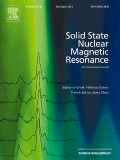
SOLID STATE NUCLEAR MAGNETIC RESONANCE
Transforming Understanding through High-Impact NMR ResearchSOLID STATE NUCLEAR MAGNETIC RESONANCE, published by Academics Press Inc Elsevier Science, stands as a prominent journal in the fields of chemistry, instrumentation, nuclear and high energy physics, and radiation, offering a unique platform for researchers and professionals to disseminate their findings and insights. Since its inception in 1992, the journal has continuously showcased innovative research that enhances our understanding of solid-state NMR techniques and applications, contributing significantly to advancements in both theoretical and practical domains. With an impressive impact factor and achieving Q2 rankings across multiple disciplines, it represents a vital resource for academics and industry experts alike, fostering interdisciplinary collaboration and knowledge sharing. While currently not open access, researchers can access valuable content through institutional subscriptions, ensuring a wide reach and influence in the scientific community. The journal's commitment to high-quality publishing makes it a must-read for those at the forefront of nuclear magnetic resonance research.

Journal of the Korean Magnetic Resonance Society
Pioneering Discoveries in Imaging and SpectroscopyJournal of the Korean Magnetic Resonance Society, published by the Korean Magnetic Resonance Society, serves as a premier platform for advancing the field of magnetic resonance research. This journal, with the ISSN 1226-6531, is dedicated to disseminating innovative studies and critical reviews in areas encompassing magnetic resonance imaging, spectroscopy, and related technologies. Based in Seoul, South Korea, it aims to foster collaboration and knowledge exchange among researchers, professionals, and students globally. Although it follows a traditional subscription model, the journal is committed to high-quality, peer-reviewed content, ensuring that published articles undergo rigorous evaluation. By bridging the gap between academia and industry, the Journal of the Korean Magnetic Resonance Society plays a vital role in pushing the boundaries of magnetic resonance science, making it essential reading for anyone engaged in this cutting-edge field.

APPLIED MAGNETIC RESONANCE
Innovating Applications of Magnetic Resonance TechnologiesApplied Magnetic Resonance, published by Springer Wien, stands as a pivotal academic journal within the realm of Atomic and Molecular Physics and Optics. Established in 1990, this journal has become a prominent platform for disseminating high-quality research papers that explore innovative applications of magnetic resonance technologies. With its ISSN 0937-9347 and E-ISSN 1613-7507, the journal is recognized for fostering a deeper understanding of the theoretical and practical aspects of magnetic resonance across various scientific fields. Despite its Q3 ranking in the 2023 Scopus category, it continues to attract a diverse readership interested in advancing the frontiers of physics. Researchers and professionals are encouraged to contribute their findings, as the journal not only enriches academic discussion but also influences real-world applications, making it an essential resource for burgeoning scientists and seasoned experts alike. Additionally, while the journal is not open access, its comprehensive articles can significantly enhance scholarly knowledge and inspire further research in this vital discipline.
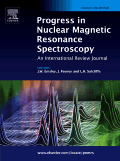
PROGRESS IN NUCLEAR MAGNETIC RESONANCE SPECTROSCOPY
Advancing the Frontiers of NMR ResearchPROGRESS IN NUCLEAR MAGNETIC RESONANCE SPECTROSCOPY, published by PERGAMON-ELSEVIER SCIENCE LTD, is a premier journal dedicated to advancing the field of Nuclear Magnetic Resonance (NMR) spectroscopy, catering to a wide audience of researchers, professionals, and students engaged in analytical chemistry, biochemistry, materials science, and nuclear physics. With an impressive reputation reflected in multiple Q1 rankings across its relevant categories for 2023, this journal is recognized for its high-quality publications that contribute significantly to the understanding and application of NMR techniques. Although not open access, it remains a vital resource for those seeking to push the boundaries of scientific knowledge and innovation in various disciplines. Published continuously since 1965, this journal not only archives a rich history of NMR research but also presents cutting-edge findings and methodologies, making it an essential reference for anyone involved in this evolving field. The journal’s focus on impactful research, evidenced by its strong Scopus rankings, ensures a scholarly platform where the latest advancements meet the methodological rigor needed for real-world applications.
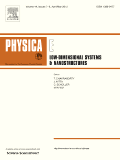
PHYSICA E-LOW-DIMENSIONAL SYSTEMS & NANOSTRUCTURES
Unveiling the mysteries of materials at the nanoscale.PHYSICA E-LOW-DIMENSIONAL SYSTEMS & NANOSTRUCTURES, published by ELSEVIER, is a premier journal dedicated to advancing the field of condensed matter and nanoscience, focusing on the innovative properties and applications of low-dimensional systems. With an esteemed Q2 ranking in multiple categories including Atomic and Molecular Physics, Condensed Matter Physics, and Nanoscience for 2023, this journal serves as a vital platform for researchers and professionals aiming to disseminate and discuss cutting-edge research. Established in 1974 and converging its focus from 1997 onwards, PHYSICA E captures the evolving landscape of material science, making it a crucial resource for anyone invested in the dynamics of electronic, optical, and magnetic materials. Although the journal operates on a subscription basis, its broad accessibility and significant placement within Scopus rankings—such as being in the 83rd percentile for Condensed Matter Physics—underscore its importance within the academic community. Researchers and students alike will find this journal a cornerstone for fostering knowledge and collaboration in the fields of nanotechnology and low-dimensional physics.
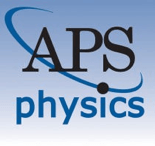
PHYSICAL REVIEW B
Unveiling Innovations in Materials SciencePHYSICAL REVIEW B, published by the American Physical Society, is a leading journal in the field of condensed matter physics and materials science, particularly focusing on electronic, optical, and magnetic materials. With an ISSN of 2469-9950 and an E-ISSN of 2469-9969, this periodical has garnered a prestigious reputation, achieving a Q1 ranking in both relevant categories as of 2023. The journal has recorded significant impact as reflected in its Scopus ranks, notably positioned at #95 out of 434 in Condensed Matter Physics and #75 out of 284 in the Materials Science sector, illustrating its importance in advancing research and discussions in these critical areas. Although it does not offer open access, PHYSICAL REVIEW B remains an invaluable resource for academics, researchers, and professionals seeking to increase their understanding of contemporary issues in condensed matter and material sciences. Established in 2005, this journal continues to foster innovation and dissemination of knowledge, making it a cornerstone publication for those engaged in cutting-edge research.

PHYSICS OF THE SOLID STATE
Illuminating the Path of Interdisciplinary ResearchPhysics of the Solid State is a distinguished journal published by Pleiades Publishing Inc., focusing on the rapid advancements and fundamental research in the realms of condensed matter physics, electronic, optical, and magnetic materials. With an ISSN of 1063-7834 and an E-ISSN of 1090-6460, this journal serves as a crucial platform for disseminating high-quality research findings, insights, and reviews essential for both academic and industrial professionals in the field. As of 2023, its Scopus ranking places it in the 26th percentile for both Condensed Matter Physics and Electronic, Optical and Magnetic Materials, reflecting its evolving influence and contribution to the scientific community. Although currently classified in the Q4 quartile, the journal aims to foster interdisciplinary dialogue, improve research visibility, and enhance its impact on contemporary scientific challenges through rigorous peer-reviewed articles and focused special issues. Despite its traditional model of access, it continues to play a pivotal role in engaging researchers and fostering innovation in solid-state physics.